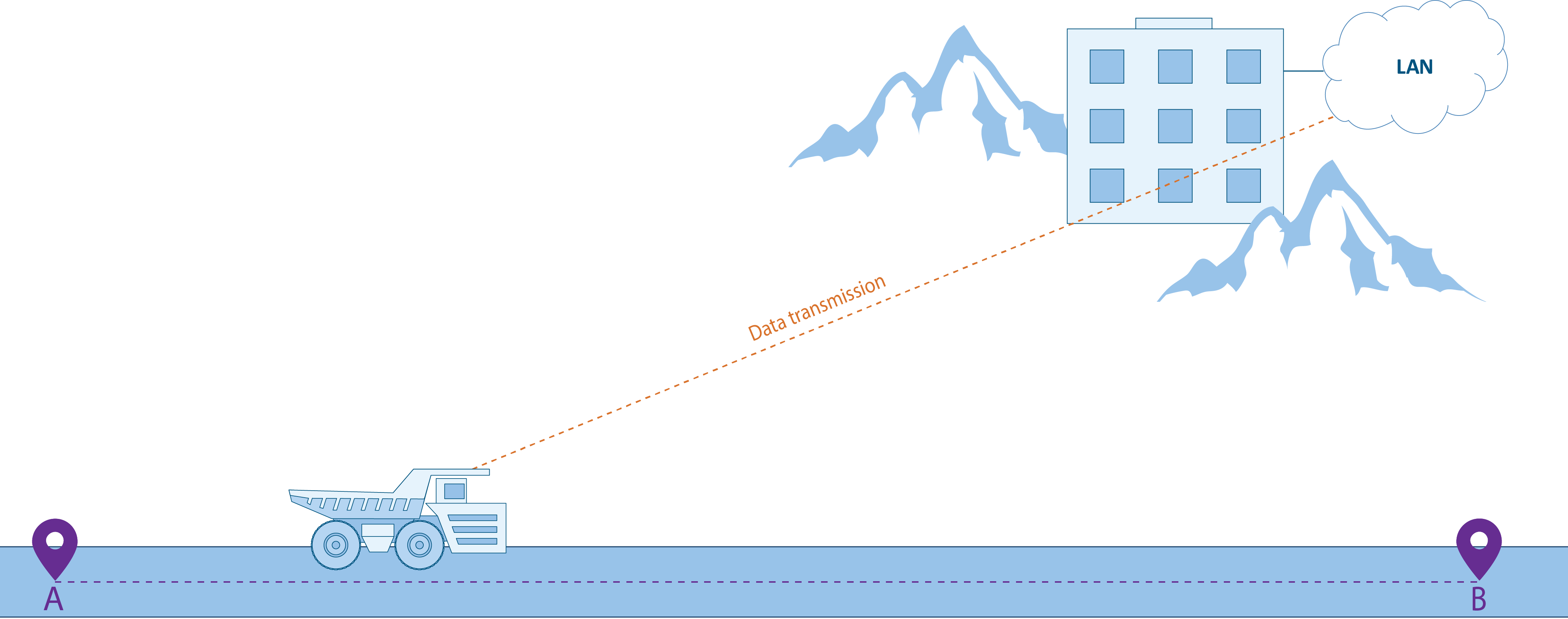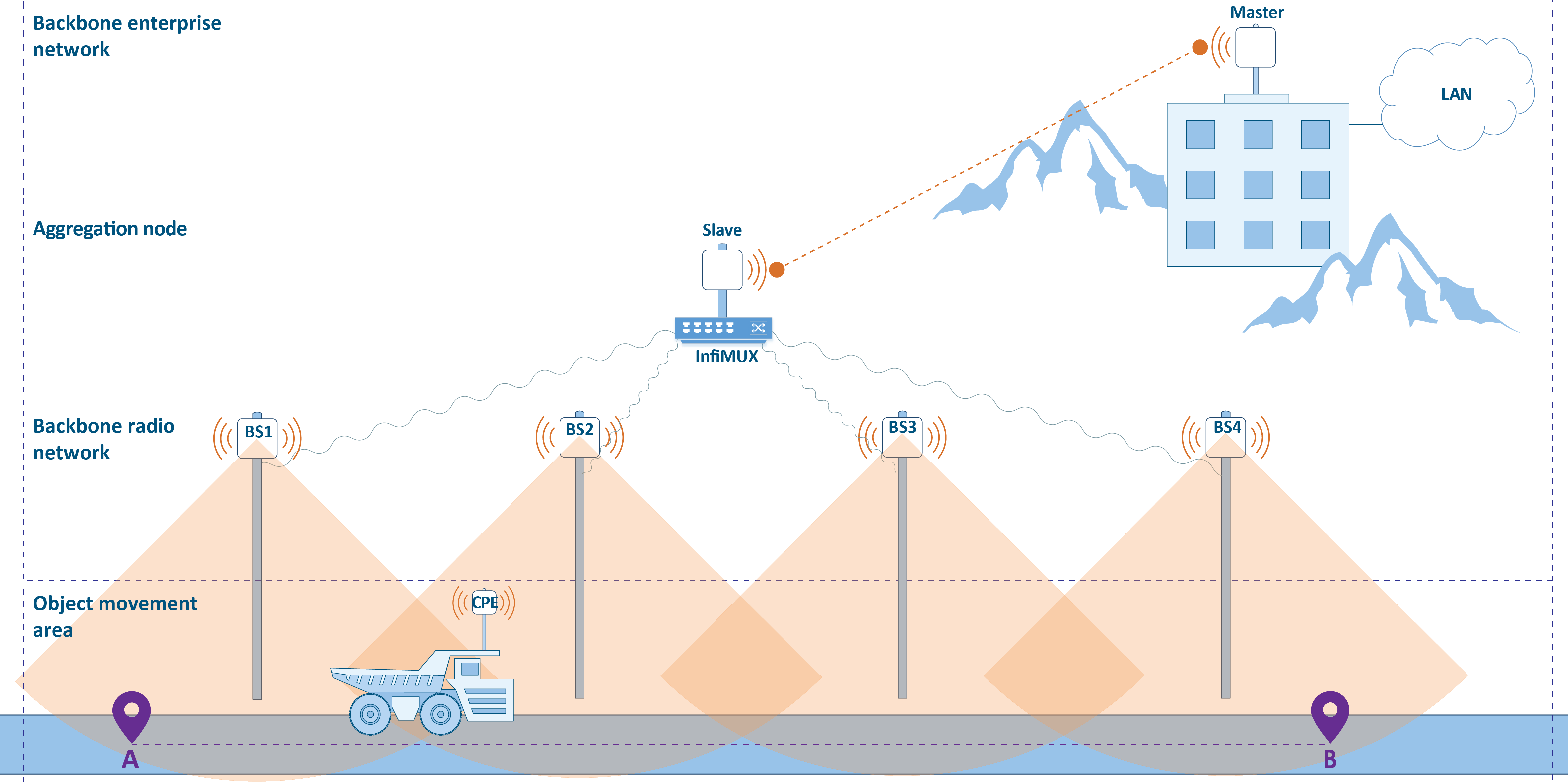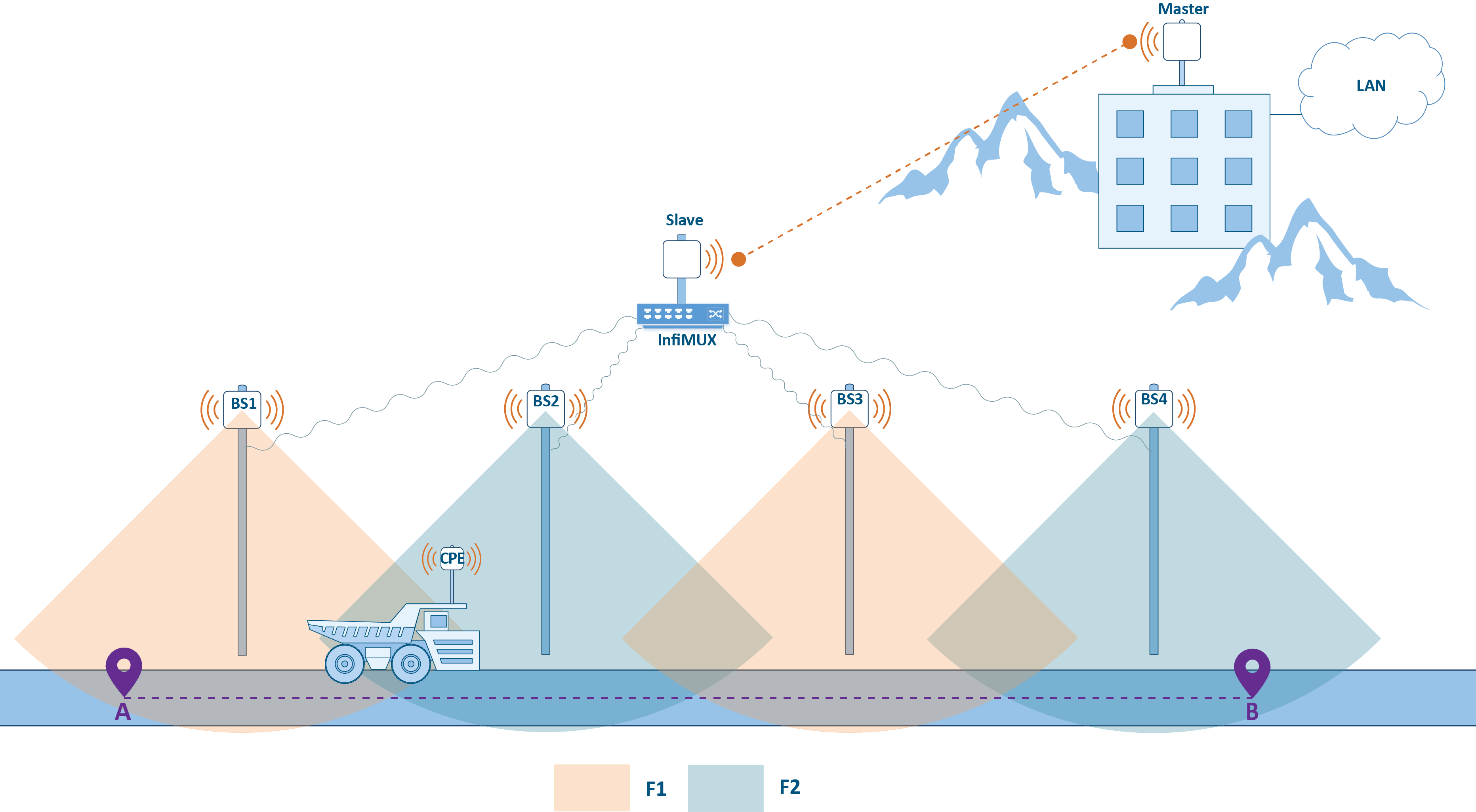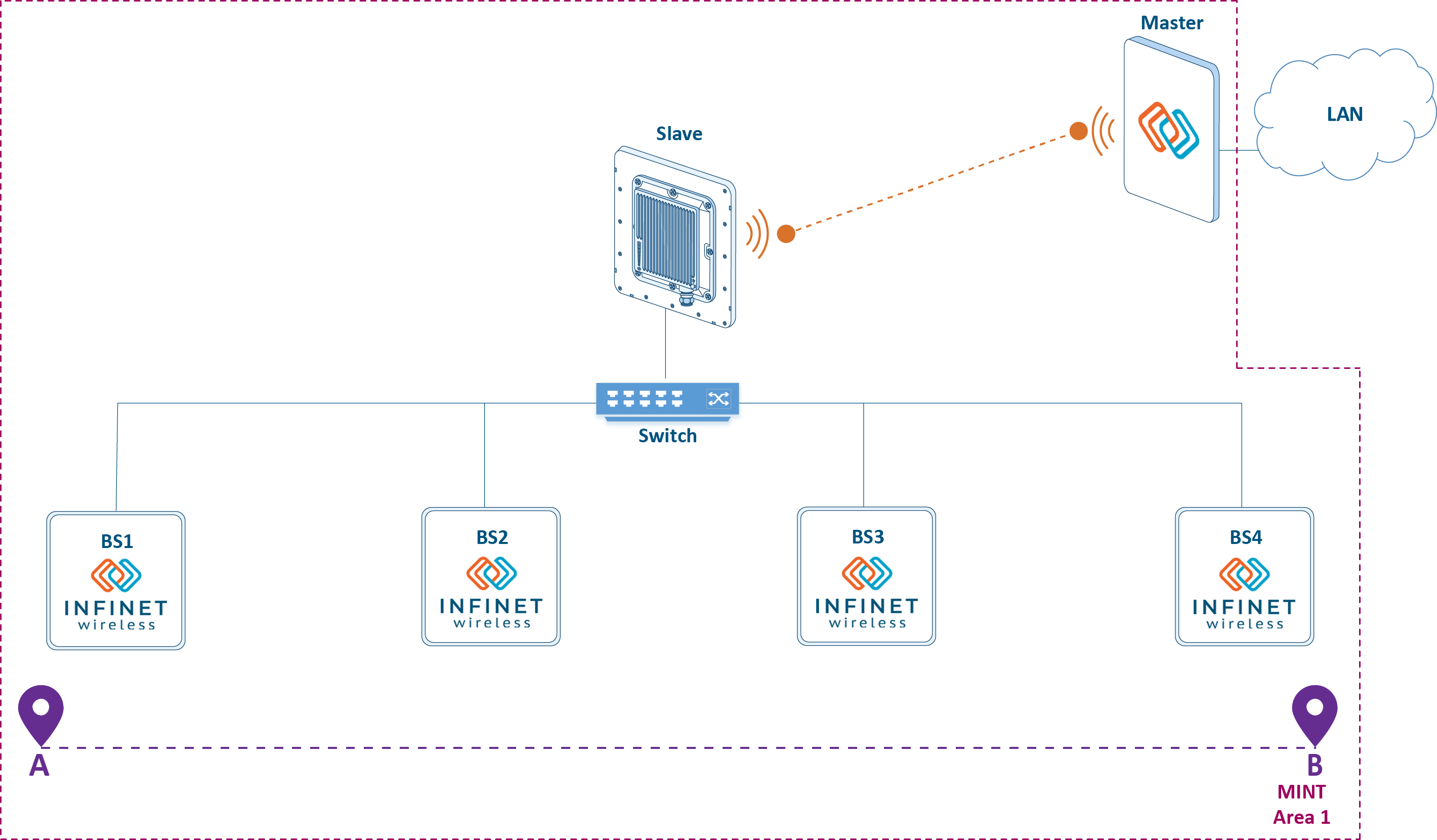| Note | |
|---|---|
This document contains sub-pages with examples:
|
Content
| Table of Contents | ||
|---|---|---|
|
Introduction
This document describes the ability of the InfiNet devices to provide sustainable wireless connectivity with mobile objects in various scenarios. A basic deployment is generally presented along with the features related to its implementation for the mining industry, railway and water transport.
Basic requirements
Let's look at the scenario below (Figure 1), which involves the movement of one or more objects throughout the enterprise area along a given path between points A and B. The network control center is located at a certain distance from the area where the moving object can be located.
The project goal is to organize a reliable wireless connectivity between the control center and the mobile objects in order to provide various information services, such as telemetry data gathering, video surveillance, telephony , etc.
| Center |
|---|
Figure 1 - Basic scenario for connectivity with mobile objects |
Two categories of tasks must be solved to achieve this goal:
- Network establishmentNetwork deployment including the following sections:
- A backbone backhaul radio network creation. The coverage of the backbone backhaul radio network should correspond to the object movement 's area of motion.
- An aggregation node creation. The aggregation node is designed to join the backbone to gather the traffic of the backhaul radio network devices and is it is a gateway between the radio network and the enterprise network.
- To establish a backbone A backbone link between the aggregation unit node and the control center.
- Fault tolerance and roaming providingcapabilities for:
- Ensuring the link fault tolerance at the access level (backhauling).
- Providing seamless subscriber roaming within the backbone backhaul radio network.
- Ensuring fault tolerance of the main link between the aggregation unit and node and the control center.
- Ensure the possibility of QoS policy implementationEnsuring the possibility of implementing QoS policies.
...
Solution
Network
...
deployment
The solution of the network establishing problems solution to the tasks described above is shown in Figure 2 . The solution can and it can be divided into four components:
- An The backbone enterprise network.An
- aggregation The aggregation node.
- A backbone backhaul radio network.Object movement area.
- The object's area of motion
The backbone backhaul radio network consists of several base stations (BS) joined , joined by a wired infrastructure. Each BS can consist of one or several sectors , the and the combination of their antenna patterns forms the radio network coverage area. As CPEs and BS sectors, the The InfiMAN 2x2 family devices can be used as CPEs and BS sectors. Keep in mind that wireless links as well as combined infrastructure can be used to join several BSs.
The base stations are joined by the aggregation node where which in our scenario is the InfiMUX switch is installeddevice. As shown below, the InfiMUX simplifies the configuration of InfiNet devices by adding all BSs configuration for the InfiNet devices by joining all the BSs into a single MINT area.
A backbone link is established between the aggregation node and the network control center. The choice of channel-forming devices is determined by the transmitted traffic capacity (see Performance of the InfiNet Wireless devices) the following throughput values can be achieved:
...
| Center |
|---|
Figure 2 - Areas distribution |
Fault tolerance and roaming
In addition to the infrastructure described earlier there is extended list of tasks, which makes the solution fault-tolerant and more efficient:
...
- The telemetry gathering service, telephony and the remote control are sensitive to delay and jitter, so they require careful configuration of traffic distribution rules by classes. Low jitter for sensitive services can be achieved by using software with TDMA technology support on InfiMAN 2x2 devices. A comparative analysis of Polling and TDMA multiple access technologies is provided in the TDMA and Polling: Application features document.
- The video surveillance service, in addition to the delay requirements, requires the throughput in the uplink from CPE to BS. The InfiMAN 2x2 devices family supports the time division multiple access method (TDMA), which allows an administrator flexibly allocate available throughput between upstream and downstream channels.
- Using a single infrastructure to provide a range of different services requires flexible allocation of available throughput between them..
| Anchor | ||||
|---|---|---|---|---|
|
Each the solution implementation is unique and requires careful preliminary planning. It is a very important stage, saving resources at the design stage can greatly increase operating costs. Within this document the radio frequency planning issues and devices placement will be reviewed.
RF planning
Frequency planning is a complex creative process that defines:
...
| Center |
|---|
b) Figure 3 - The allocation of frequency channels between BS: a - using four channels, b - using two channels |
Device allocation
The device position in space determines the actual quality indicators of the wireless link. The position of the device is determined by:
...
The InfiNet product portfolio includes a wide range of accessories, including mounting kits that allow to install devices in various conditions with the possibility of flexible alignment, and the CAB-RV1 alignment tool which allows to perform preliminary device diagnostics.
MINT protocol
Ethernet link layer protocol was developed for wired networks and does not take into account the specifics of the wireless environment. Wireless device manufacturers can use standard wireless protocols, such as Wi-Fi, or use their own developments. InfiNet Wireless company is developing a proprietary data transfer protocol called MINT designed for data exchange in a wireless environment.
MINT (Mesh Interconnection Network Technolohy) - InfiNet's proprietary technology used in InfiLINK 2x2 and InfiMAN 2x2 family devices, provides data transfer between devices via wireless and wired links.
MINT area
One of the MINT protocol main concepts is the MINT area. A MINT area consist of many neighboring devices, data exchange between them is carried out using MINT frames (see "MINT protocol" lesson of the InfiLINK 2x2 and InfiMAN 2x2: Switching online course).
...
Data transfer and QoS configuration on each wireless devices is a time-consuming task that can be simplified by expanding the MINT area. Schemes intended to reduce the wireless devices configuration by combining them into a single MINT area are shown below.
| Anchor | ||||
|---|---|---|---|---|
|
The main disadvantage of the solution above is a necessary switch groups configuration on all wireless devices. Since the switch group is a gateway between MINT and Ethernet, it is possible to combine all the BSs of the radio network into a single MINT area by assigning the gateway function to the InfiMUX switch (see Figure 5). In this case, the switch group is need to be configured only on InfiMUX. Joining devices into a single MINT area and the advantages of such a scheme are described in the InfiLINK 2x2 and InfiMAN 2x2: Switching online course.
...
The advantages of such solution is the simplification of the QoS configuration, as traffic processing rules for different service classes are configured only on InfiMUX.
Joining sectors and the backbone link in one MINT area
The disadvantage of the scheme with backbone radio network devices joining in a single MINT area is the quality of service policy complication: the used traffic classification rules must be duplicated on InfiMUX and on the Master and Slave devices. If these rules are not duplicated, the effect of QoS policy implementation can be significantly reduced.
...
| Center |
|---|
Figure 6 - Joining all wireless devices in a single MINT area |
Roaming
The movement of the mobile object with CPE installed, within the backbone radio network is accompanied by a transition from the coverage area of one BS sector to another sector coverage area of same or another BS. The CPE transition process between BS sectors is called roaming. Roaming is accompanied with radio link brake with the first sector and the connection establishment with the second sector.
...
| Center | ||||||||
|---|---|---|---|---|---|---|---|---|
Video 2 - Roaming mechanism |
Radio link establishing
A radio link can be established between two devices if the following requirements are met:
- At least one device has a Master role. Possible connections: Master-Master, Master-Slave. The solution architecture suppose configuration of BS sectors as Masters, and CPEs as slaves.
- A radio profile has been created in CPE configuration, corresponding to the radio settings on the BS.
- Signal parameters (RSSI, SNR, etc.) allow data exchange at least at the minimal modulation.
Radio profiles
On Master devices, only one set of radio parameters can be configured, which will be used to establish links. On Slave devices, several radio profiles can be created, or one with the ability to automatically select a frequency. Configuration via CLI:
...
Obviously, link establishing can be a longtime operation when the automatic frequency selection mode is used due to the wide range of frequencies supported by the radio module. It is unacceptable in scenarios with roaming, therefore, we recommend to create separate radio profiles for each BS sector of the backbone radio network in CPE configuration.
Dynamic frequency selection
Master devices same as a Slave, support the dynamic frequency selection (DFS) mode. Devices with DFS support, before selecting a frequency, scan the available frequency channels, evaluate the interference level and the radars presence. Operation channel is selected among the frequency channels free of radar, with a minimum interference level.
...
Enable DFS on the Master device:
Code Block language text theme Emacs title DFS enable dfs rf5.0 dfsonly dfs rf5.0 freq auto
Enable DFS and Radar detection on the Master device:
Code Block language text theme Emacs title DFS and Radar detection enable dfs rf5.0 dfsradar dfs rf5.0 freq auto
Enable iDFS support on the Master and Slave devices:
Code Block language text theme Emacs title iDFS enable mint rf5.0 -idfs
Frequency roaming
In this document frequency roaming is a change of the link operating frequency, i.e. frequency change is performed on both devices.
...
Note that a Slave device with "roaming enable", having received a command to change the operating frequency from the "roaming leader", will switch to another frequency channel even if there is no corresponding radio profile in the Slave device configuration. In this case, after a reboot, the slave will not be able to establish a link, because will be guided by a set of radio profiles added to the configuration.
| Anchor | ||||
|---|---|---|---|---|
|
The main disadvantage of the roaming mechanism is that CPE, after breaking the link with BS1, tries to restore this connection and, only after several unsuccessful attempts, searches for other BSs to establish the new connection. InfiNet devices support the proprietary MultiBS function, which speed up this process.
...
| Code Block | ||||||
|---|---|---|---|---|---|---|
| ||||||
mint rf5.0 roaming enable multiBS |
Global function
Let's look at the scenario in which the cable route between the InfiMUX and the BS1 power injector was damaged (see Figure 7), i.e. power is supplied to BS1 and the device is ready to establish radio connections, but data can not be transmitted to the control center.
...
Enable Global function on InfiMUX:
Code Block language text theme Emacs title Global function on InfiMUX mint prf0 roaming enable global
| Anchor | ||||
|---|---|---|---|---|
|
One of the mechanisms determining the moment of disconnection from one sector and establishing connection with another is the assessment SNR values threshold. Two thresholds are used in a wireless device configuration:
...
| Code Block | ||||||
|---|---|---|---|---|---|---|
| ||||||
mint rf5.0 -loamp 0 |
Fixed/mobile/nomadic modes
One of the factors affecting the link parameters with a moving object is the relevance of the MINT frame redirection table. This configuration can only be applied on the InfiLINK 2x2 and InfiMAN 2x2 families devices. Device configuration allows to set the update interval for the MINT redirection table entries by choosing one of the three "mode" parameter values:
...
Set mobile mode on the Master and Slave devices:
Code Block language text theme Emacs title Mobile mode configuration mint rf5.0 -mode mobile
| Anchor | ||||
|---|---|---|---|---|
|
As shown above, MultiBS function speeds up the CPE roaming between the BSs, however, in any case, roaming is accompanied by a short break in connection. Link interruption avoidance can be reached by using two CPEs on a moving object, combined by InfiMUX. In this case, each CPE will independently establish a radio link with the BS, and InfiMUX will distribute data traffic between those links.
...
| Code Block | ||||||
|---|---|---|---|---|---|---|
| ||||||
config save |
Additional materials
Online courses
- Wireless Networking Fundamentals.
- InfiPLANNER: Link Planning Tool.
- InfiLINK 2x2 and InfiMAN 2x2: Switching.
White papers
- Performance of the InfiNet Wireless devices.
- Link aggregation, balancing and redundancy.
- TDMA and Polling: Application features
- Dynamic Frequency Selection.
Webinars
- InfiNet Wireless equipment installation, grounding and lightning protection.
- Switching configuration using InfiNet Wireless devices - typical scenarios.
- InfiNet Wireless PtMP network design with frequency reuse and SYNC.



